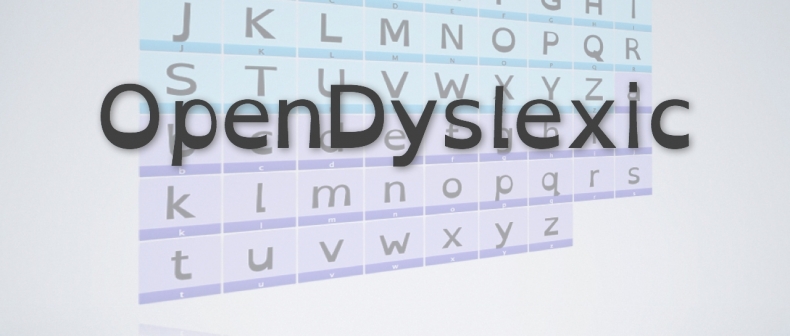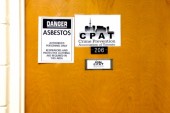
Abelardo Gonzalez is not dyslexic, but when he stumbled across a student paper written in a dyslexic-friendly typeface, he could read it much more easily than regular typefaces.
It piqued his interest. He wanted to find a version available in the US that he could introduce to his dyslexic friends. No such version existed, for free anyway. If you were a publisher then you could acquire those rights, but these were simply not feasible for the average person.
So set in motion an arduous task that morphed into a massive game changer for dyslexics worldwide. Gonzalez singlehandedly designed OpenDyslexic. The typeface has been proven to amend some issues dyslexics have with reading. He gave the letterforms weighted bottoms, which helps to secure them on the page. Through careful kerning (the spaces between the letters) and leading (the spaces between the lines), OpenDyslexic alleviates common dyslexic problems like, “letter rotation, swapping letters because they look similar, and letters that are drifting and moving around.”
His typeface can be downloaded for free by anyone. It has been integrated into Instapaper and Kobo readers, even paperbacks will be printed using his revolutionary font. He developed openWeb, which enables you to read documents on your iPhone or iPad in OpenDyslexic.
Dyslexia is a learning disorder which affects between 5 and 10 per cent of the population. In its broadest understanding, it “impairs a person’s fluency or comprehension accuracy in being able to read.” It is often misunderstood and can lead to accusations of laziness or stupidity. While reading, dyslexics may struggle with letters appearing to swoop and dip across the page, or to look like different letters altogether.
Online, one can operate virtually unrestrained from dictates of gender, age and geography. Dyslexia is one of the last bastions where a struggle remains to achieve parity. Literacy is the great equalizer, and those with access to and interpretation of the written word are always at advantage.
Toronto Standard caught up with Gonzalez yesterday as he was returning from giving a TEDTalk on OpenDyslexic in Mumbai. “I thought it was just going to remain my little hobby project, lost in a corner. I didn’t expect it to actually take off so rapidly and become so popular.”
The New Hampshire-based man has a full-time job and freelances programming jobs on the side. He would work all night perfecting his typeface. Initially, he had no knowledge of typography. He investigated the history of different typefaces, and was fascinated with how the technical language still borrowed from printing press terminology. Through careful research and close deliberation with his dyslexic friends, he cobbled together the letterforms for his typeface. He used a program called FontForge to make the letters, now he uses a program called Glyphs.
“Some letters, like the B, I make adjustments to still. The lower case ‘b’, I just made another adjustment to it… So, I didn’t have a process where I sat down and did it sequentially — this is the ‘A’, this is the ‘B’ type of thing. I was kind of all over the place. One of the first things I did was letter shapes, because at the time I thought typeface was only letter shapes; and the spacing and kerning was magically done elsewhere. But I figured that out pretty quickly. There were sprints of months where I would just focus on one section.”
Once his initial typeface had been perfected, Google asked him to develop a dyslexic-friendly italic font for them. “Everything I’d read up until that point was like, ‘you generally don’t want to do an italic typeface, especially for dyslexics.’ And I didn’t want to say it was impossible. Partially because Google said we need an italic typeface and partially because I thought; ‘what if it is possible?” He worked as fast as he could, sending out version after version to his dyslexic friends every few hours, fine-tuning the letters.
He has always maintained that he would not ask for money for his product, that he wanted attribution only. Had he made it for purchase, it would be a risk for companies to take on, and a risk for individuals to buy (if it didn’t end up working for them). He was threatened with legal action from Christian Boer, who designed the commercial typeface, Dyslexie (a dyslexic-friendly typeface which costs users several hundred euros).
The dismal threatening letter from Boer and general exhaustion were starting to take their toll. It was Gonzalez’s wife who provided the steadfast encouragement he needed to go on. “If I was doing it alone I think it would be incredibly challenging. There were times where I’ve been discouraged and she’s always been there for me. She’s been the encouragement I needed to continue working on it. She’s been the pat on my back when I needed it.”
In the US, you cannot copyright a letterform, so Boer had no case. Gonzalez ignored the threats and kept at it. His current work involves expanding into other languages. “I am trying to add more international characters — that’s my current work on it, and to make a fixed width font so you can use it for programming.”
The most rewarding part is when he sees people discovering his typeface for the first time. “Their eyes light up, they get incredibly excited. The emails from people like that are incredibly encouragaing. You’d get emails like ‘this is the first time ever I could read so well.’ In public schools in the US, dyslexia isn’t really well understood. And teachers will tell these kids, ‘You’re lazy, you’re just not trying hard enough.’ And instead of teachers and parents trying to help these students, they just beat on them, verbally. So its very emotional when people go through life like that and then come across something like this.”
When asked if he wanted to totally eradicate dyslexia, Gonzalez was adamant that was not the case. “Not everybody is made the same way. We don’t have the same brain obviously. In China, or countries that use a picture-type character in their alphabet, you’ll find many fewer dyslexics. It turns out it’s not because there are fewer dyslexics in those countries — it’s because the way the language is structured, it doesn’t affect them. It doesn’t hinder their ability to read and such.”
“They found out in some studies that dyslexics could learn Japanese incredibly easily, which would be difficult for most people. And so, my thinking is more with the flawed (Roman alphabet) system than with the dyslexic mind. And to take away what makes someone dyslexic would also take away much of their creativity, much of what makes them that person. I don’t think theres anything wrong with a dyslexic person. It’s just they have difficulty reading a flawed system.”
You can download OpenDyslexia here.
Watch Gonzalez’s TEDtalk here. (Session 2, Begins at 0:31:00)
____
Tiffy Thompson is a writer and illustrator for the Toronto Standard. Follow her on Twitter at @tiffyjthompson.
For more, follow us on Twitter at @TorontoStandard and subscribe to our newsletter.














